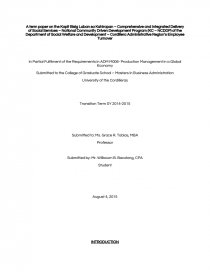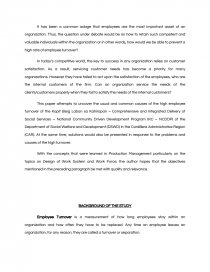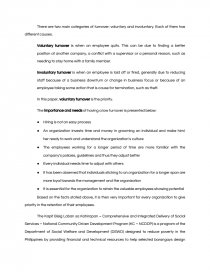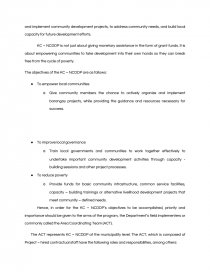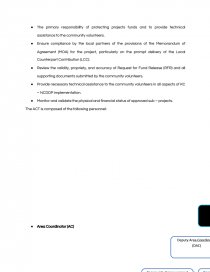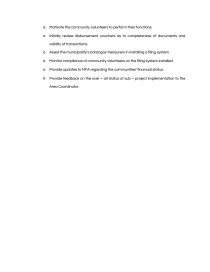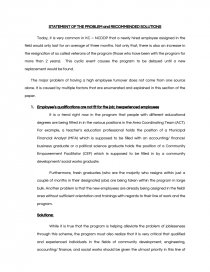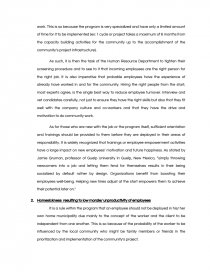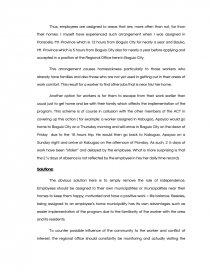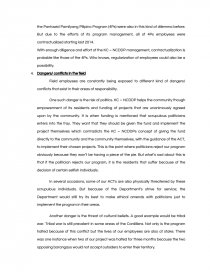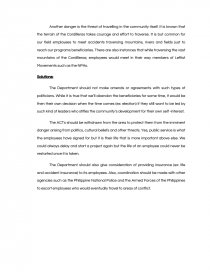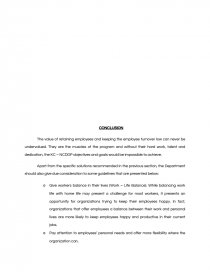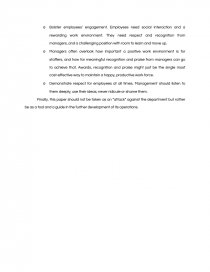Kapit Bisig Laban Sa Kahirapan – Comprehensive and Integrated Delivery of Social Services
Essay by wilbourn • September 20, 2015 • Term Paper • 3,861 Words (16 Pages) • 1,910 Views
Essay Preview: Kapit Bisig Laban Sa Kahirapan – Comprehensive and Integrated Delivery of Social Services
A term paper on the Kapit Bisig Laban sa Kahirapan – Comprehensive and Integrated Delivery of Social Services – National Community Driven Development Program (KC – NCDDP) of the Department of Social Welfare and Development – Cordillera Administrative Region’s Employee Turnover
In Partial Fulfilment of the Requirements in ADM M006- Production Management in a Global Economy
Submitted to the College of Graduate School – Masters in Business Administration
University of the Cordilleras
Transition Term SY 2014-2015
Submitted to: Ms. Grace R. Tobias, MBA
Professor
Submitted by: Mr. WIlbourn B. Bacolong, CPA
Student
August 4, 2015
INTRODUCTION
It has been a common adage that employees are the most important asset of an organization. Thus, the question under debate would be on how to retain such competent and valuable individuals within the organization or in other words, how would we be able to prevent a high rate of employee turnover?
In today’s competitive world, the key to success in any organization relies on customer satisfaction. As a result, servicing customer needs has become a priority for many organizations. However they have failed to act upon the satisfaction of the employees, who are the internal customers of the firm. Can an organization service the needs of the clients/customers properly when they fail to satisfy the needs of the internal customers?
This paper attempts to uncover the usual and common causes of the high employee turnover of the Kapit Bisig Laban sa Kahirapan – Comprehensive and Integrated Delivery of Social Services – National Community Driven Development Program (KC – NCDDP) of the Department of Social Welfare and Development (DSWD) in the Cordillera Administrative Region (CAR). At the same time, solutions would also be presented in response to the problems and causes of the high turnover.
With the concepts that were learned in Production Management particularly on the topics on Design of Work System and Work Force, the author hopes that the objectives mentioned in the preceding paragraph be met with quality and relevance.
BACKGROUND OF THE STUDY
Employee Turnover is a measurement of how long employees stay within an organization and how often they have to be replaced. Any time an employee leaves an organization, for any reason, they are called a turnover or separation.
There are two main categories of turnover: voluntary and involuntary. Each of them has different causes.
Voluntary turnover is when an employee quits. This can be due to finding a better position at another company, a conflict with a supervisor or a personal reason, such as needing to stay home with a family member.
Involuntary turnover is when an employee is laid off or fired, generally due to reducing staff because of a business downturn or change in business focus or because of an employee taking some action that is cause for termination, such as theft.
In this paper, voluntary turnover is the priority.
The importance and needs of having a low turnover is presented below:
- Hiring is not an easy process
- An organization invests time and money in grooming an individual and make him/ her ready to work and understand the organization’s culture
- The employees working for a longer period of time are more familiar with the company’s policies, guidelines and thus they adjust better
- Every individual needs time to adjust with others
- It has been observed that individuals sticking to an organization for a longer span are more loyal towards the management and the organization
- It is essential for the organization to retain the valuable employees showing potential
Based on the facts stated above, it is then very important for every organization to give priority in the retention of their employees.
The Kapit Bisig Laban sa Kahirapan – Comprehensive and Integrated Delivery of Social Services – National Community Driven Development Program (KC – NCDDP) is a program of the Department of Social Welfare and Development (DSWD) designed to reduce poverty in the Philippines by providing financial and technical resources to help selected barangays design and implement community development projects, to address community needs, and build local capacity for future development efforts.
KC – NCDDP is not just about giving monetary assistance in the form of grant funds. It is about empowering communities to take development into their own hands so they can break free from the cycle of poverty.
The objectives of the KC – NCDDP are as follows:
- To empower local communities
- Give community members the chance to actively organize and implement barangay projects, while providing the guidance and resources necessary for success.
- To improve local governance
- Train local governments and communities to work together effectively to undertake important community development activities through capacity - building sessions and other project processes.
- To reduce poverty
- Provide funds for basic community infrastructure, common service facilities, capacity – building trainings or alternative livelihood development projects that meet community – defined needs.
Hence, in order for the KC – NCDDP’s objectives to be accomplished, priority and importance should be given to the arms of the program, the Department’s field implementers or commonly called the Area Coordinating Team (ACT).
The ACT represents KC – NCDDP at the municipality level. The ACT, which is composed of Project – hired contractual staff have the following roles and responsibilities, among others:
- The primary responsibility of protecting projects funds and to provide technical assistance to the community volunteers.
- Ensure compliance by the local partners of the provisions of the Memorandum of Agreement (MOA) for the project, particularly on the prompt delivery of the Local Counterpart Contribution (LCC).
- Review the validity, propriety, and accuracy of Request for Fund Release (RFR) and all supporting documents submitted by the community volunteers.
- Provide necessary technical assistance to the community volunteers in all aspects of KC – NCDDP implementation.
- Monitor and validate the physical and financial status of approved sub – projects.
The ACT is composed of the following personnel:[pic 1]
[pic 2][pic 3][pic 4][pic 5]
[pic 6][pic 7]
[pic 8][pic 9]
[pic 10][pic 11][pic 12][pic 13][pic 14][pic 15][pic 16]
- Area Coordinator (AC)
- Protect project funds. As one of the co – signatories of the community’s bank account, he/ she shall ensure that all disbursement vouchers are reviewed by the MFA before signing the check.
- Assist the communities in resource accessing.
- Coordinate with Donors to ensure timely delivery of committed local counterparts.
- Evaluate the request of the communities for technical assistance fund.
- Review, evaluate and sign Request for Fund Release (RFR).
- Review and approve all financial reports prepared by the MFA and ensure that these and other financial documents especially the original paid disbursement vouchers and its supporting documents are submitted completely and on time to the Regional office.
- Investigate issues and complaints and immediately submit written report and recommendations to the Regional office.
- Deputy Area Coordinator (DAC)
- Act as an alternative co – signatory of all financial transactions at the community level in the absence of the AC.
- Provide adequate technical assistance to the different barangay Project Preparation Team (PPT) in the preparation of sub – project concepts for the Municipal Inter – Barangay Forum for Participatory Resource Allocation (MIBF – PRA) so that proposals submitted are realistic, especially in regards to the cost estimates.
- Conduct technical review of the sub – project proposals submitted by the communities. The review will include but not limited to the following:
- Detailed Cost Estimates used in the proposed budget;
- Assignment of monetary values to local contributions in kind;
- Assessment of the capability of communities to contribute.
- Assist the Audit and Inventory Committee, through job coaching in the:
- Inspection of the delivery of materials;
- Audit of materials inventory;
- Valuation of unutilized materials.
- Monitor the physical progress of sub – project implementation and regularly compare against the MFA’s records of the community’s fund utilization.
- Provide regular updates to the Area Coordinator.
- Municipal Financial Analyst (MFA)
- Provide technical inputs and the preparation and review of Program of Works (POW) particularly on the reasonableness of costs and appropriateness of items charged under the Indirect Costs.
- Review all RFR’s including completeness, validity and consistency of data of all required supporting documents. Maintain RFR tracking system.
- Review and sign all disbursement vouchers prior to AC’s signature of check.
- Monitor and validate financial sub – project status of the communities through field visits.
- Monitor delivery and utilization of LCC including Municipal Trust Account based on the approved LCC plan and provides timely feedback to AC for appropriate action in case of potential delay.
- Initiate Municipal Fiduciary Workshops.
- Prepare and timely submit municipal financial monitoring reports to the Regional office. Make sure that soft copies of reports are properly backed – up with hard copies.
- Provide regular financial updates to the MCT and other stakeholders.
- Submit monthly feedback report to the Regional Financial Analyst as regards to community financial management system.
- Provide regular updates to the AC.
- Community Empowerment Facilitator (CEF)
- Motivate the community volunteers to perform their functions.
- Initially review disbursement vouchers as to completeness of documents and validity of transactions.
- Assist the municipality’s barangay treasurers in installing a filing system.
- Monitor compliance of community volunteers on the filing system installed.
- Provide updates to MFA regarding the communities’ financial status.
- Provide feedback on the over – all status of sub – project implementation to the Area Coordinator.
STATEMENT OF THE PROBLEM and RECOMMENDED SOLUTIONS
Today, it is very common in KC – NCDDP that a newly hired employee assigned in the field would only last for an average of three months. Not only that, there is also an increase in the resignation of so called veterans of the program (those who have been with the program for more than 2 years). This cyclic event causes the program to be delayed until a new replacement would be found.
...
...
